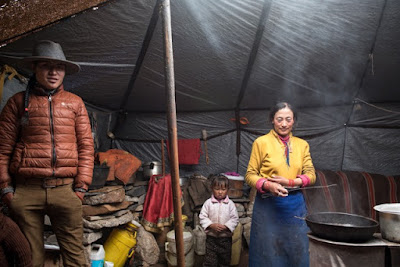 |
| Cold and gray morning at Camp Six |
 |
| We're crossing where? |
As we walked upward, Gary and Dharma asked local herders about the best point at which to cross the swollen stream flowing (and at points roaring) through our approach. Approaching a herders' camp --note the (tethered) barking dog and yak hair double-wide (yak hair tent established over a legacy stone foundation), Tinsley engaged a young herder, who like many Tibetans we see and meet in the mountains, was curious about our group. After a short conversation, the herder confirms our crossing is at an old blue truck ahead; and then invites us into his tent to observe the traditional (nomadic) way living of in this season when they are grazing their yaks in the valley.
 |
| Tibetan double wide |
 |
| In the herders' tent |
 |
| Gary and the kitten |
At the very end of our visit, Gary (quite smitten with the resident ratter) signaled to Cliff and Karl that it would be fine to ask about taking photos. Not only were the man and his wife receptive, the man even accepted Tinsley's iPhone and took a picture of all of us in the tent -- iPhone knowledge was there, no instruction required.
 |
| Yak fuel patties drying (making these is women's work) |
 Leaving the herders' tent, we walked on and finally located the blue truck and our stream crossing (a lovely stone bridge of sorts). As is normal, the camp staff carrying our lunch passed us (with smiles and beautiful even breaths -- I am so jealous for the Tibetan DNA) mid-morning. They unpacked our lunch above the stream in a field littered with yak patties (I am so used to sitting next to/on yak poo that it hardly registers any more).
Leaving the herders' tent, we walked on and finally located the blue truck and our stream crossing (a lovely stone bridge of sorts). As is normal, the camp staff carrying our lunch passed us (with smiles and beautiful even breaths -- I am so jealous for the Tibetan DNA) mid-morning. They unpacked our lunch above the stream in a field littered with yak patties (I am so used to sitting next to/on yak poo that it hardly registers any more).  |
| Yak yogurt |
Camp Seven (tonight) is at 16,600 feet. From our camp site we can see two valleys leading to passes. One we'll explore tomorrow, and the second we will follow in two days time to cross (we hope) to Sha-shing pass.
Our yak men camp with us each night, unsaddling and releasing their yaks to graze each afternoon when we arrive at camp. I constantly am impressed by the calm
confidence all three yak men display in dealing with these giant beasts. And I must say, I find yak to be much more docile (and less scary) than the
cattle in the fields across England last summer.
 |
| Arriving at Camp Seven |
 |
| Wooden yak saddles stacked at camp while the yak graze |
No comments:
Post a Comment